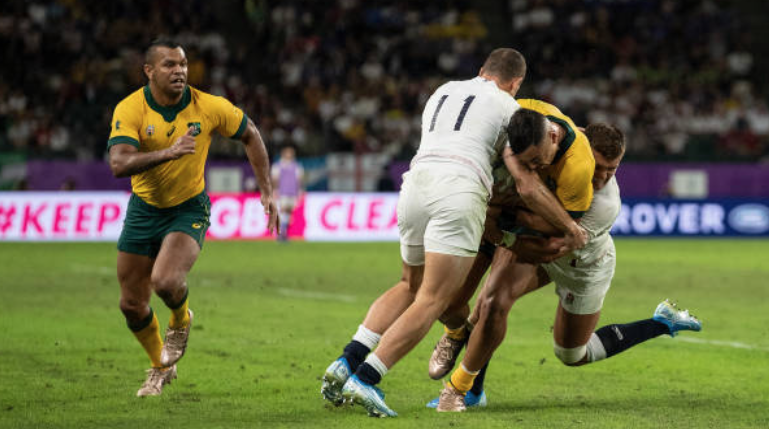DYLAN JACK looks at where the World Cup quarter-final between England and Australia in Oita on Saturday was won and lost.
DEFENCE
The statistics for the game read like it should really have gone in Australia’s favour. The Wallabies completely dominated the attacking side of the game, making more than twice as many runs (153 to 71) and gainline carries (52 to 25). They also came out well on top in terms of passes (165), defenders beaten (21), clean breaks (14) and rucks won (113), embracing coach Michael Cheika’s philosophy.
How, then, did they manage to lose a game they appeared to dominate?
One of the big keys is in England’s defence, which has been incredibly well organised and set up by assistant coach John Mitchell this year. England made 196 tackles to Australia’s 86, but importantly only missed nine more tackles than the Wallabies, for a higher success rate of 90%.
As can be seen in the example of Jonny May’s second try, England’s press defence forced Australia into errors. The phase leading up to May’s try actually began with a promising Wallabies attack. Lock Maro Itoje does excellently to not only make a good tackle, but also disrupt Will Genia at the breakdown, forcing the Australian scrumhalf to throw a poor pass to David Pocock, who takes the ball to line but is well met by Tom Curry. Pocock decides to throw the pass which is intercepted by Henry Slade, who toes the ball ahead to allow May to gather and ground the ball over the tryline.
This was just one such example of England forcing Australia to make a poor decision with a fast linespeed. Australia did not help themselves by ignoring the warning signs and continuing to persist with attacks from their own 22, with Kurtley Beale also throwing an intercepted pass late in the match.
KICKING
England took the opposite approach to Australia when it came to their attacking game plan. Simply put, England refused to play from out of their own half, deciding instead to apply pressure through a number of well-placed kicks.
It should come as no surprise that the English starting halfbacks, Owen Farrell and Ben Youngs, put boot to ball a combined seven more times than Australia’s Will Genia and Christian Leali’ifano did. In fact, England’s replacement flyhalf George Ford, kicked more times in 20 minutes than both Leali’ifano and his replacement Matt Toomua did combined.
CONVERSION RATE
This all leads up to England’s conversion rate on attack. When England got near, or ventured into, Australia’s 22, they nearly always came away with points.
England collected 31 points from seven visits to Australia’s 22, an exceptional conversion rate.
In the face of England’s physical pack and uncompromising defence, Australia could not do the same.
Photo: David Ramos – World Rugby/World Rugby via Getty Images





